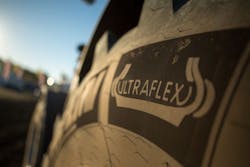AG Tire Talk: Manufacturers Explain Product Names and Tech
QUESTION: What are some proprietary tire manufacturer naming conventions and technologies?
Dave Paulk, manager, field technical services, BKT USA Inc.: Syncing with how we continue to evolve as a company — building even more sophisticated and technologically advanced products, along with standard numeric naming conventions — we have added names applicable to specific equipment and tire performance.
The Agrimax Sirio is a high-speed tire developed for high-performance tractors. Some sizes are increased flexion (IF)-rated to carry loads at lower air pressure.
The Agrimax Spargo tire is designed with very-high flexion (VF) technology to carry heavier loads at standard air pressures for reduced soil compaction.
The Agrimax Spargo tire is designed with VF technology to carry heavier loads at standard air pressures. The Agrimax Teris is designed for harvesters, cotton pickers and grain carts. Most sizes are cyclic harvest operation (CHO) or IF-CFO-rated to carry heavy loads in cyclic operations and minimize soil compaction.
Dana Berger, ag business development manager, Continental Specialty Tires: The simplicity behind Continental’s proprietary naming focuses on making the products stand out. Continental tries to reach customers by describing different attributes of our products.
N.flex technology is Continental’s unique way of providing our agriculture radial tires with flexibility for impact, without permanent deformation.
d.fine technology creates a deep lug overlap and allows smooth linkage between the tread block and tire base. This technology also will decrease vibration and therefore can create a quieter experience when on the road.
Continental agriculture radial tires follow a simple naming structure related to their aspect ratio. Tractor85 has an aspect ratio of 85%, while Tractor70 has an aspect ratio of 70%.
The term “Master” in Continental’s CombineMaster and TractorMaster expresses the pursuit of offering advanced technologies. Both are part of Continental’s portfolio of radial agricultural tires.
Greg Gilland, vice president, global agricultural program, Maxam Tire International: Our radial ag tires are designed to deliver a simple, yet effective range of tires grouped by aspect ratio and size to meet current — as well as future — equipment evolution.
Provided are Maxam nomenclature and tire sizing conventions: AGRIXTRA 85 — tires that have “80” or “85” in their sizes; AGRIXTRA 70 — tires that have “70” in their sizes; AGRIXTRA 65 — tires that have “65” in their sizes; AGRIXTRA XL — tires for high-horsepower tractors or harvesters with “70” and “65” aspect ratios; AGRIXTRA H — high-volume tires for harvester or floater applications; AGRIXTRA N — narrow-application tires with “90” or “100” aspect ratios for tractors or sprayers; and FLOTXTRA — steel-constructed tires for high-load applications.
David Graden, operational market manager, agriculture, Michelin North America Inc.: Over the years, Michelin has invented numerous ag tire technologies, several of which are global standard today. The Michelin “Self Cleaning Hinge” is probably the most basic concept. The idea is to reduce mud adhesion by allowing air between mud and the casing.
Probably the greatest Michelin agricultural invention is UltraFlex technology. Michelin invented UltraFlex in the late-’90s/early 2000s.
A lesser-known technology is our Stubble Shield rubber compounds. As genetically modified products became the norm, producers needed a tire that could stand up to the new extreme stubble.
We also have begun stamping many of our IF and VF tires with “Air Systems Ready” on the sidewall. This all started with Michelin acquired a central tire inflation company. We realized we needed to be sure our tires could handle the constant increase and decrease in air pressures while working.
Scott Sloan, ag product manager/global LSW, Titan International Inc.: Low Sidewall Technology — otherwise known as LSW — is exclusive to Titan and is a combination of our wheel and tire technologies.
Tires with LSW feature a larger rim diameter and a smaller sidewall than a standard tire, while maintaining the same outside diameter of a comparable standard tire. LSW tires meet the same load and inflation capabilities as VF and CFO tires, meaning they can help reduce soil compaction. They are also designed to help eliminate ride quality problems, such as power hop and road lope.
LSW technology is available in a variety of sizes — from row crops to flotation — on combines, tractors, grain carts and more.
Norberto Herbener, OE applications engineer, Trelleborg Wheel Systems: Trelleborg’s Blue Dimension technology offers benefits like higher crop yields, lower fuel consumption and reduced carbon dioxide emissions.
Inter-Lug Terracing is an advanced design at the base of the lug that helps with mud ejection — maximizing the self-cleaning capability of the tire.
Wing-Effect enlarges the tread width. A wider tread means less compaction, better traction, more even wear and a smoother ride.
About the Author
AG Tire Talk
Modern Tire Dealer has partnered with AG Tire Talk to provide answers to insightful questions that farm tire dealers have about farm tire technology. This is the latest installment in our ongoing series, which is designed to help farm tire dealers better connect with their customers. A trending question, followed by answers, appears in the Commercial Tire Dealer section of MTD every other month. For complete answers, go to www.agtiretalk.com.
